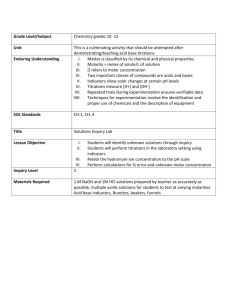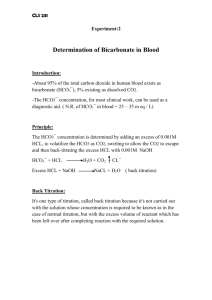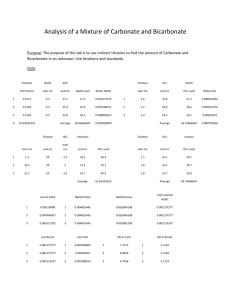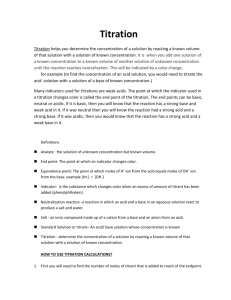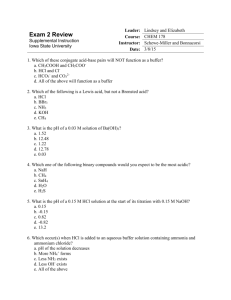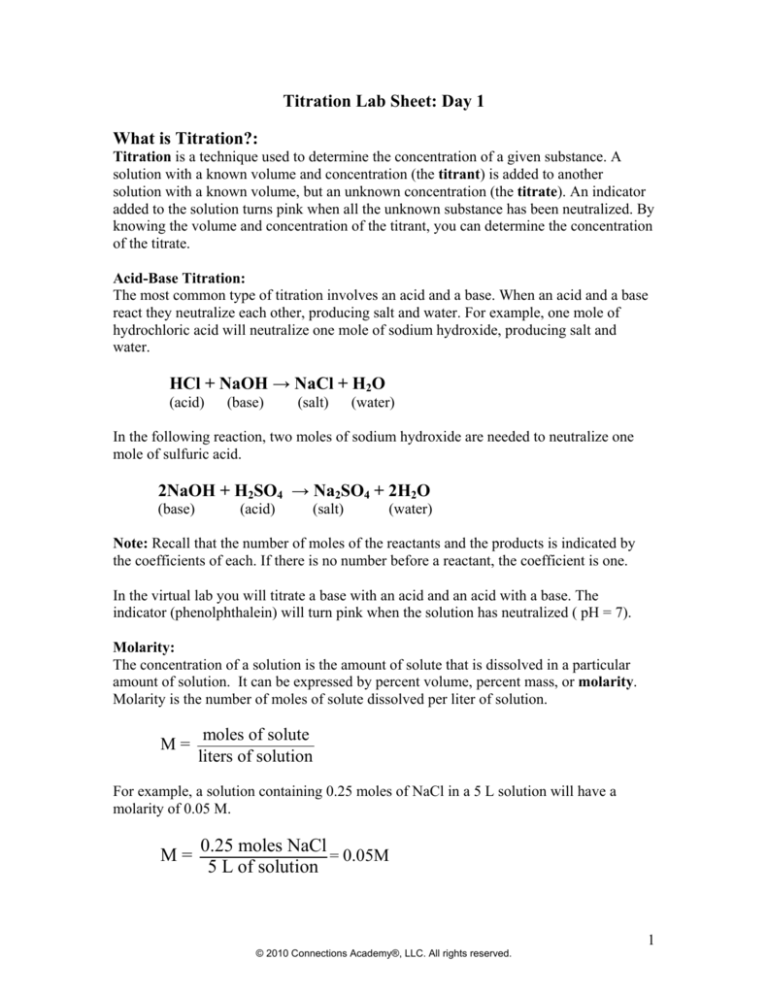
Titration Lab Sheet: Day 1
What is Titration?:
Titration is a technique used to determine the concentration of a given substance. A
solution with a known volume and concentration (the titrant) is added to another
solution with a known volume, but an unknown concentration (the titrate). An indicator
added to the solution turns pink when all the unknown substance has been neutralized. By
knowing the volume and concentration of the titrant, you can determine the concentration
of the titrate.
Acid-Base Titration:
The most common type of titration involves an acid and a base. When an acid and a base
react they neutralize each other, producing salt and water. For example, one mole of
hydrochloric acid will neutralize one mole of sodium hydroxide, producing salt and
water.
HCl + NaOH → NaCl + H2O
(acid)
(base)
(salt)
(water)
In the following reaction, two moles of sodium hydroxide are needed to neutralize one
mole of sulfuric acid.
2NaOH + H2SO4 → Na2SO4 + 2H2O
(base)
(acid)
(salt)
(water)
Note: Recall that the number of moles of the reactants and the products is indicated by
the coefficients of each. If there is no number before a reactant, the coefficient is one.
In the virtual lab you will titrate a base with an acid and an acid with a base. The
indicator (phenolphthalein) will turn pink when the solution has neutralized ( pH = 7).
Molarity:
The concentration of a solution is the amount of solute that is dissolved in a particular
amount of solution. It can be expressed by percent volume, percent mass, or molarity.
Molarity is the number of moles of solute dissolved per liter of solution.
M=
moles of solute
liters of solution
For example, a solution containing 0.25 moles of NaCl in a 5 L solution will have a
molarity of 0.05 M.
M=
0.25 moles NaCl
= 0.05M
5 L of solution
© 2010 Connections Academy®, LLC. All rights reserved.
1
Sample Titration:
•
A solution of hydrochloric acid (HCl) has an unknown concentration.
•
25 ml of the HCl solution is placed in a flask.
•
3 drops of phenolphthalein are added to the HCl solution.
(Phenolphthalein is clear in acids but turns pink in bases.)
•
A buret is filled with a sodium hydroxide (NaOH) solution which has a known
concentration of 0.10 M.
•
The base (NaOH) is added, drop by drop, to the acid (HCl) until the acid-base
solution just begins to turn pink and the pH reaches 7, indicating that the base has
neutralized the acid.
•
By reading the buret, it is found that 30 ml of NaOH was needed to neutralize the
HCl.
What Happened in the Titration:
•
In the reaction between NaOH and HCl, 1 mole of NaOH reacts with 1 mole of
HCl.
1 NaOH + 1 HCl → 1 NaCl + 1 H2O
(Mole ratio of NaOH to HCl is 1:1)
•
The concentration of the NaOH was 0.1 M, or 0.1 moles/liter.
•
Since 30 ml (or 0.03 liters) of NaOH was used for the titration,
0.03 liters · 0.1 moles/liter = 0.003 moles of NaOH was used to titrate the HCl.
•
Since the mole ratio is 1:1, the same number of moles (0.003) of HCl must have
been titrated.
•
This means that the beaker contained 0.003 moles of HCl in 25 ml (0.025 liters) of
solution.
•
Therefore the concentration of the HCL is 0.003 moles/0.025 liters, or 0.12 M.
© 2010 Connections Academy®, LLC. All rights reserved.
2
Sample Titration Calculations:
Note: You will not have to use the following steps to complete the Virtual Lab, but you
will use them to complete the hands on Cabbage Juice pH / Titration Lab. The Virtual
Lab will set up and complete all calculations. You only have to enter the required data
you obtain while completing the lab.
Problem:
30 ml of 0.10M NaOH neutralized 25.0ml of HCl.
Determine the concentration of the HCl?
1. Write the balanced chemical equation for the reaction
NaOH + HCl → NaCl + H2O
2. Extract the relevant information from the question:
NaOH
V = 30 mL , M = 0.10 M
HCl
V = 25.0 mL, M = ?
3. Convert milliliters to liters
NaOH
V = 0.03 L , M = 0.10 M
HCl
V = 0.025 L, M = ?
4. Calculate moles NaOH:
n(NaOH) = M x V = 0.10 moles/L x 0.03L = 3 x 10-3 moles
5. From the balanced chemical equation find the mole ratio
NaOH:HCl = 1:1
6. Find the number of moles of HCl that were titrated.
NaOH: HCl is 1:1,
so n(NaOH) = n(HCl) = 0.003 moles at neutralization.
7. Calculate the concentration of HCl:
M=n÷V
n = 0.003 mol, V = 0.025L
M(HCl) = 0.003 moles ÷ 0.025 L = 0.12 moles/L or 0.12M
© 2010 Connections Academy®, LLC. All rights reserved.
3
Titration Lab Procedures:
•
•
•
•
•
•
•
•
•
•
Click on “Go to Titration Lab.”
Click on the “Help” link and watch the tutorial. Use the Play, Pause, and Replay
buttons as necessary.
After watching the tutorial, click on the “Back to Lab Home” link.
At the Homepage, click on the “Go to Lab” link.
Select the “Assessment” button, and then click the “Proceed” arrow.
Begin the Question 1: Acid-Base Titration exercise. Following the instructions in
the margin for each step of the titration.
Record your data in the table provided.
For Question 1, the correct HCL concentration is 0.1 M. If you do not get this
concentration, repeat the Question 1 titration exercise.
After you complete the Question 1 exercise, begin the Question 2: Base-Acid
Titration exercise. You should get a concentration of 0.2 M for the base.
Be sure to follow lab safety rules while performing the titrations. You will receive
a Safety Score when you have completed the lab.
Titration Tips:
Tip #1: It is very easy to “overshoot”
the endpoint, so do not add the
solution from to buret too fast. Begin
with the Whole Drop option. Once the titration curve begins to bend, switch to the Split
Drop option. Remember to shake the flask after each drop.
Tip #2: The endpoint of the titration is reached when the base
just neutralizes the acid. As the endpoint approaches, the titration
curve will begin to bend sharply. Stop when the pH reaches 7.
Tip #3: Enter values into the Calculator section correctly. The
values for the ‘known’ substance go in the numerator and the
values for the ‘unknown’ substance go in the denominator.
Tip #4: The number of moles of reactants and products is
indicated by the coefficients of each. Use the coefficients to
determine the mole ratios for your calculations.
HCl + NaOH → NaCl + H2O
Mole ratio of acid to base is 1:1
2NaOH + H2SO4 → Na2SO4 + 2H2O
Mole ratio of base to acid is 2:1
© 2010 Connections Academy®, LLC. All rights reserved.
4
Titration Lab Day 1 Data Sheet:
Question #1 Exercise—Acid-Base Titration:
Balanced Equation
__________ + _________ → ________ + _________
Acid-Base Titration
Acid
Solution
Molar Ratio
Volume
Concentration
(unknown)
Base
(known)
Question #2 Exercise—Base-Acid Titration:
Balanced Equation
__________ + _________ → ________ + _________
Base-Acid Titration
Base
Solution
Molar Ratio
Volume
Concentration
(unknown)
Acid
(known)
© 2010 Connections Academy®, LLC. All rights reserved.
5


